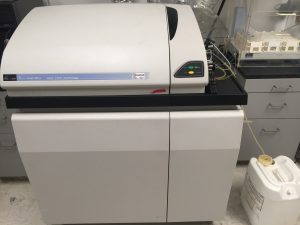Ion-Coupled Plasma-Mass Spectrometry/ICPMS
ICPMS Testing Services:
 ECA has many years of experience in elemental analysis. We have been testing metals and nonmetals in nearly every possible matrix. We have capabilities in every possible digestion method and will employ the most appropriate digestion as it relates to protecting the sample integrity and completely digesting all elements in a given sample. We primarily use the ICPMS technique in our laboratory for elemental analysis. ICPMS (Ion Coupled Plasma Mass Spectroscopy) is a very good method which adds the sample throughput ease of ICP-AES with the sensitivity of Graphite Furnace AA to give a very powerful elemental analysis technique. Below are some of the features of ICPMS:
ECA has many years of experience in elemental analysis. We have been testing metals and nonmetals in nearly every possible matrix. We have capabilities in every possible digestion method and will employ the most appropriate digestion as it relates to protecting the sample integrity and completely digesting all elements in a given sample. We primarily use the ICPMS technique in our laboratory for elemental analysis. ICPMS (Ion Coupled Plasma Mass Spectroscopy) is a very good method which adds the sample throughput ease of ICP-AES with the sensitivity of Graphite Furnace AA to give a very powerful elemental analysis technique. Below are some of the features of ICPMS:
• ICPMS has a very good analytical working range, up to 9 orders of magnitude.
• ICPMS has instrument detection limits at or below the part per trillion (ppt) level for most elements on the periodical chart.
• ICPMS can perform isotopic analysis.
ICPMS (Ion-Coupled Plasma Mass Spectrometry) is a very sensitive elemental analysis method with a wide range of elements detectable. ECA has 2 rugged Perkin Elmer ELAN DRCe systems that we employ for elemental analysis. We have many years of experience in the analysis of even the most difficult sample types. ICPMS can be used to quantify over 70 elements. The following elements can be detected using ICPMS in our laboratory:
Calcium, Sodium, Magnesium, Aluminum, Potassium, Lithium, Iron, Mercury, Nickel, Manganese, Copper, Zinc, Cobalt, Lead, Arsenic, Cadmium, Gallium, Selenium, Rubidium, Strontium, Silver, Chromium, Scandium, Yttrium, Lanthanum, Cerium, Praseodymium, Neodymium, Samarium, Europium, Gadolinium, Terbium, Dysprosium, Holmium, Erbium, Thulium, Ytterbium, Lutetium, Thorium, Molybdenum, Vanadium, Antimony, Cesium, Barium, Palladium, Tin, Platinum, Gold, Titanium, Hafnium, Iridium, Tellurium, Rubidium, Beryllium, Germanium, Zirconium, Niobium, Tantalum, Tungsten, Rhenium, Boron, Thallium, Rhodium, Uranium, Sulfur.
ICPMS is not amenable to the analysis of the following:
Carbon, Nitrogen, Oxygen, the halogens: Chlorine, Fluorine, Bromine, Iodine, and Astatine, and the gases: Hydrogen, Helium, Neon, Argon, Krypton, Xenon, and Radon.
We usually do not analyze the highly radioactive elements: Nobelium, Lawrencium, Mendelevium, Fermium, Einsteinium, Californium, Berkelium Curium, Americium, Plutonium, Neptunium, Promethium, Polonium, Astatine, Radon, and Francium, and Radium.
Elemental analysis can be done on samples as small as 0.1 mg (although we prefer 500 to 1000 mg if sample is in abundance). Sensitivity is also reduced with smaller sample sizes.
We are not restricted by sample matrix, we have seen them all. We have tested minerals, metal alloys, pharmaceuticals, consumer products, polymers, biological formulations, consumer products, organic mixtures, unknown residues, and many other sample types using this technique.
Our ICPMS instrumentation can reach detection limits in low parts per trillion in some cases. Generally, most elements can be quantified in the parts per billion range with sufficient sample available.
